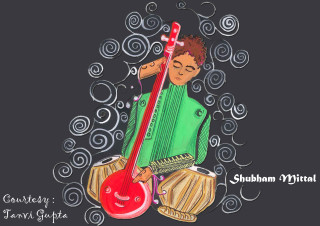Hey guys I hope you liked my article about the Time theory of raagas. Well, now talking about instruments I’ll be talking about the drone instrument Tanpura in detail. I will explain each and every part of the Tanpura one by one. To the extent possible I’ll use English only but as it is hindustani music I’ll have to use hindi also.

Above shown in the picture are some parts of a Tanpura. A Tanpura is a very vital instrument in a Hindustani music a concert. It gives a scale or a constant vibrating note to the singer. Now I’ll explain each part and their use one by one. Starting from the left side of the picture and moving anti-clockwise-
- Tuning Pegs – There are generally 4 pegs in a tanpura or sometimes maybe 6 too as per the number of strings in the tanpura. Each string is attached to one tuning peg at the top of the tanpura. These pegs are used to tune the strings of a tanpura to a particular note.
- Strings – There are 4-6 strings in a tanpura. As told before also the strings are tuned to a particular set of notes. The 1st string is tuned to Pa or the Ma of the lower octave (Mandra Saptak). The 2nd and the 3rd strings are tuned to the Sa of the middle/singing octave (Madhya Saptak). These two strings are also known as the air strings or the Jodi ki taar. The 4th and the last string is tuned to the Sa of the lower octave (Mandra Saptak). If there are 6 strings then 2 more middle octaves Sa are added along with the jodi ki taar.
- Tabli- The face of the Tanpura is known as tabli. This is made up from wood and is the frontal designed part of the tanpura.
- Beads and Threads- The strings of the tanpura starts from the tuning pegs and go up till the base of the tanpura and are tied up there with the help of an iron nail. On the face of the tanpura (tabli) there is a bead in each string and a soft thin thread is inserted in between the strings and the wood. These are very essential components of a tanpura as they help in very fine tuning of the strings. A slight change in the position of these beads and threads can detune the instrument.
- Tumba- Tumba or the base of the tanpura is hollow and made up of a Gourd or a pumpkin.
- Gul- It is the point where the tumba of the tanpura ends and the neck of the tanpura start. It is the connecting point between the base and the neck of the tanpura.
- Daand- It is the long part of the tanpura also known as the neck of the tanpura.
Hope you liked knowing about this instrument in detail. Now I would like to talk about Raaga Yaman
Raaga Yaman-
Aaroh– Ni Re Ga, MA Pa Dha Ni Sa
Avroh– Sa” Ni Dha Pa MA Pa Dha Pa MA Ga Re Ni Dha Ni Re Sa
Pakad– Ni Re Ga Re Ga MA Pa Re Ni Re Sa
Thaat– Kalyan
Vadi Swara- MA (Tivra Madhyam)
Samvadi Swara– Ni
Jaati- Sampoorn- Sampoorn
Time of Singing- 1st hour of Night (Raat ka Pratham prahar)
This raaga starts with Ni Re instead of the traditional habit of starting any Raaga with Sa. Sometimes the Pancham (Pa) is skipped in the Aaroh. If a singer sings Shudhh Madhyam then this raaga is known as Yaman Kalyan. It is the main raaga of its thaat and the thaat is named after this raaga. Generally this is the 1st Raaga to be taught to students. This raaga is performed by all and very common to hear in various concerts. It is an evening raaga due to which most of the musicians start their performances with this raaga only.
You can listen this raaga by following the below links-
Raaga Yaman by Ustad Vilayat Khan (Sitar) – https://www.youtube.com/watch?v=tGBKs7swowk
Raaga Yaman by Pandit Jasraj (Vocal) – https://www.youtube.com/watch?v=g8Z3kS9xk5c
Raaga Yaman by Pandit Hari Prasad Chaurasia (Flute) – https://www.youtube.com/watch?v=WwBxqWEG7cY
Raaga Yaman by Ustad Amjad Ali Khan (Sarod) – https://www.youtube.com/watch?v=fPOnmMWcF1w
While ending this article I would like to thank each and every one of you for reading my articles and giving a constant feedback which has helped me improve a lot and has enhanced my knowledge of music also. Please do read, share and comment on this article as well.
Thank You
Shubham Mittal :-)

































